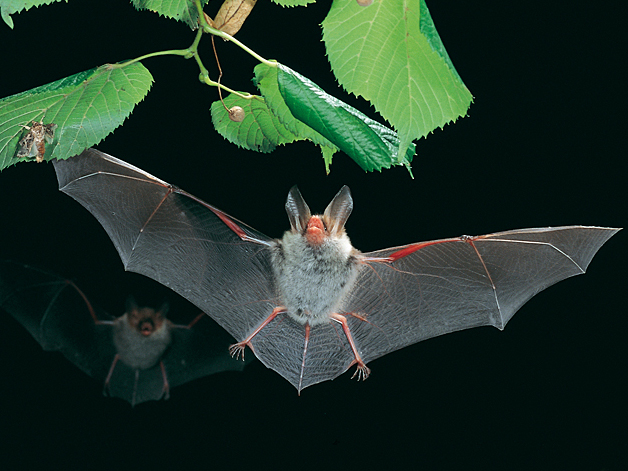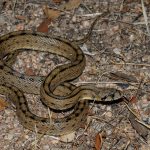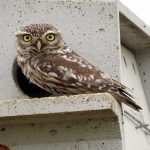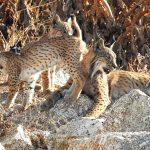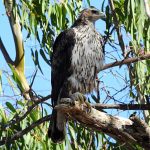Extremadura is also one of the communities with the greatest biodiversity of chiropters. Nowadays, there are 23 species of bats of Extremadura, we will mention here the most outstanding ones.
Their essential conservation problems are the limited availability of refuges and the loss of quality of their main habitats. Their main predators are the nocturnal raptors. However, when they are hibernating in caves, other predators such as cats or snakes may also appear from time to time.
Cave bats
Common bent-wing bat Miniopterus schreibersii
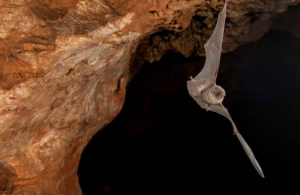
This species is more frequent in the province of Cáceres than in that of Badajoz. Its conservation status is delicate, although it is not currently endangered. Medium sized, it is easy to identify by its flat snout and tiny ears. It uses underground shelters in which groups of hundreds of individuals can be concentrated in a huddle.
Common pipistrelle and Soprano pipistrelle Pipistrellus pipistrellus y Pipistrellus pygmaeus
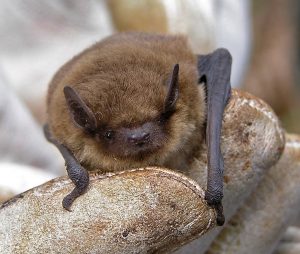
They are two very similar species that were separated at the end of the 20th century. Both are very small bats of Extremadura, not exceeding 5 cm in length and have a smooth brown coat. Pipistrellus pygmaeus usually has a lighter snout. Both are distributed throughout Extremadura, including urban environments, in which Pipistrellus pygmaeus is more abundant. Both species feed on insects, mainly diptera, and take refuge in small cracks, both in buildings and in tree holes.
Daubenton’s bat Myotis daubentonii
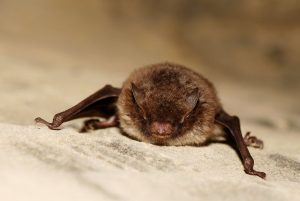
It is another bat of the genus Myotis of medium size and that can present 2 types of colorations: one with brown back and whitish belly and another blackish with grayish belly. Daubenton’s bat is distributed throughout the region, although it is scarce to the south of Badajoz and feeds on a great variety of invertebrates. It is a species closely linked to river courses, both rivers and streams and reservoirs, as it feeds near the surface of the water.
European free-tailed bat Tadarida teniotis
Large bat (between 22 and 55 grams) that is characterized by its large rounded ears. In nature it takes refuge in rocky cracks, but it has adapted very well to urban centres, taking refuge in human constructions. It is the bat with the least capacity for manoeuvre, which is why it settles in easily accessible shelters and usually hunts at several hundred metres above ground level. It is distributed throughout Extremadura.
Geoffroy’s bat Myotis emarginatus
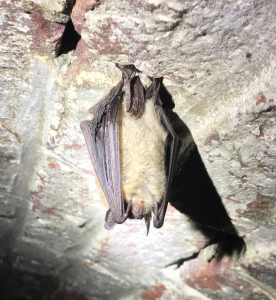
It is a medium-sized bat (weighs between 7 and 15 grams) that has a notch on the edge of the ear. It is also characterized by its woolly coat and yellow / red on the back. Geoffroy’s bat lives preferably in woods and riverbank copses, as it has a slow flight but is very manoeuvrable. It feeds on all types of arthropods which it captures mainly in flight. It is not particularly abundant but it is not seriously threatened either and its main populations are to the north and east of Cáceres.
Greater horseshoe bat Rhinolophus ferrumequinum
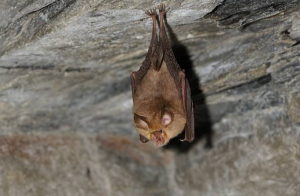
This bat, considered sensitive to habitat alteration, is distributed throughout the region. It feeds on flying insects and forms numerous colonies. Of medium size (15 to 30g) it usually hibernates underground. The rest of the year it is located in very varied shelters: attics, cavities, tunnels…
Greater mouse-eared bat Myotis myotis
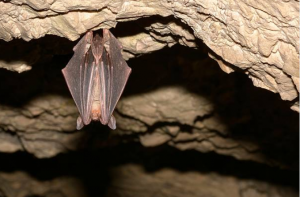
This species, sensitive to habitat alteration, is still distributed throughout the region, mainly at its extremes. Its size is “large”, these bats can weigh from 20 to 35 grams. They are also cavemen, although we can also find them in bridges and some buildings.
Lesser horseshoe bat Rhinolophus hipposideros
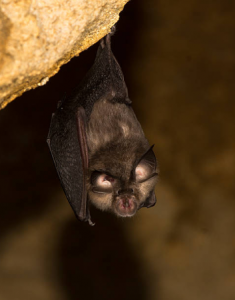
In the vulnerable category, its population is not very abundant, but it is distributed throughout the region. It is practically a miniature replica of the large horseshoe bat, one of the smallest bats in Extremadura (4 to 9 grams). It takes refuge in caves, mines and human constructions and prefers forest or bush areas with a certain degree of humidity.
Lesser mouse-eared bat Myothis blythii
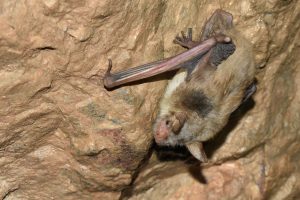
Also sensitive to habitat alteration, its populations are very rare. We find the main strongholds to the west and northwest of the region. It shares habitat with the big bat, but its size is slightly smaller and its populations much more reduced.
Mediterranean horseshoe bat Rhinolophus euryale
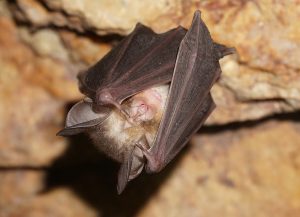
In danger of extinction, most of its populations are found in the northwest of Cáceres, southwest of Badajoz, west of the region in the Tajo Internacional area and in the Villuercas. Also caveman, its average size is from 8 to 18 grams and it is easily confused with the medium sized horseshoe bat.
Mehely’s horseshoe bat Rhinolophus mehelyi
Another endangered species, with a distribution almost identical to that of the Mediterranean Horseshoe Bat. Its size is also very similar (10 to 18 grams). Both species tend to stay away from rural areas, as they are not comfortable with human presence.
Savi’s pipistrelle Hypsugo savii
Small bat, slightly larger than Pipistrellus pipistrellus and associated with large mountain areas. It is characterized by a long and lustrous coat, in variable colors from brown to blond, having the areas devoid of blackish hair. This bat usually takes refuge in rock fissures, although it can also take refuge in buildings. It feeds on winged insects, both in the valleys and on the mountainsides, even reaching the mountain meadows on the summits. We can find it in the mountains of Gata, Gredos and Villuercas.
Serotine bat and meridional serotine Eptesicus serotinus y Eptesicus isabellinus
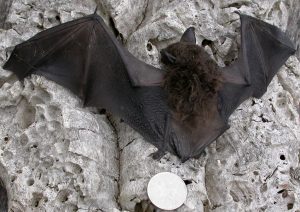
Until a few years ago they believed themselves to be one species, as their differences are tremendously subtle. Both are bats of good size, between 13 and 24 grams, with variable coloration, between reddish brown and blond. The specimens of Eptesicus isabellinus usually have a lighter coloration. Both take refuge in human constructions, rock fissures and even trees. Their habitat is very varied, from agro-livestock areas to forest edges, river courses, even parks and gardens. They feed on large insects and are distributed throughout Extremadura.
Forest bats. Bats of Extremadura
Bechstein’s bat Myotis bechsteinii
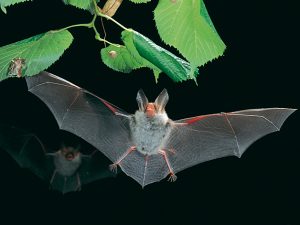
Another of Extremadura’s endangered bats. It is present mainly in the province of Cáceres, both in the north and in the east and west, being more scarce in the centre. Medium sized and with large ears, it is very dependent on mature deciduous forests. Here it feeds on small flying invertebrates.
Brown long-eared bat Plecotus auritus
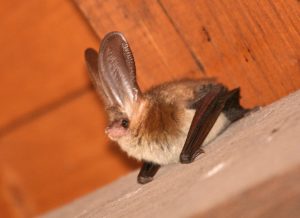
This species of bat is characterized by its large eyes and ears. Similar to the grey eared bat, it differs from it in its golden coloration on the back and whitish belly. Very scarce in the region, there are only a few fragmented populations in the forests of northern Cáceres, both in Gata and Gredos. It lives in mountain deciduous forests, especially above 900 metres. It feeds on both flying and terrestrial invertebrates.
Greater noctule bat Nyctalus lasiopterus
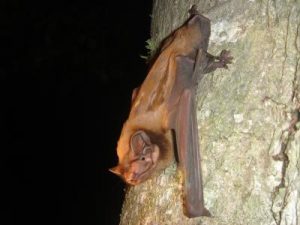
It is the largest of the European bats, normally weighing between 40 and 75 grams. It has a shiny reddish-brown coat and short, wide ears. This bat lives in mature forests, with good-sized trees and good availability of holes in which it takes refuge. It feeds on large prey, becoming capable of catching small birds. There is an important reproductive nucleus in the area of Hervás and it is catalogued as a vulnerable species.
Grey long-eared bat Plecotus austriacus
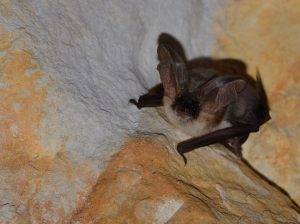
Very similar to the brown long-eared bat, in addition to other subtleties is different in the coloration, having the back grey and being darker in general. We generally find it associated with rural areas in which it takes advantage of holes in buildings for shelter. It lives in areas where we can find mosaics of crops and not very thick trees. The grey-long eared bat feeds mainly on winged invertebrates and is relatively common. It is present in different areas of both the province of Cáceres and that of Badajoz.
Kuhl’s pipistrelle Pipistrellus kuhlii
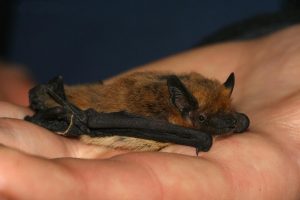
A little more robust than the rest of the bats of the genus Pipistrellus, its coloration varies between reddish brown and light brown. With a fissure-like habit, it spreads throughout the region thanks to its good capacity to adapt and its population is considered abundant. It feeds on flying invertebrates in all types of biotopes and is common in pastures, rural environments and riverbanks.
Lesser noctule Nyctalus leisleri
Medium sized bat, similar in appearance to the large native bat that inhabits the medium and high sierras of Extremadura. It hunts in semi-open wooded areas, above the tree canopy, mainly flying insects such as butterflies or beetles. This noctule takes refuge in tree holes and also uses the shelter boxes when they are present. It is considered frequent in deciduous forest stands and is not particularly threatened at present.
Western barbastelle Barbastella barbastellus
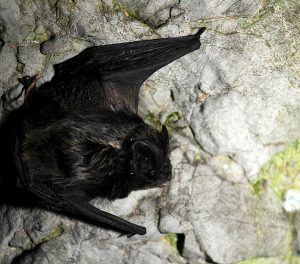
Very rare species in the community, we found some individuals north of it in the area of Hervás, Baños de Montemayor, La Garganta… Of medium size, its “square” ears and dark fur give it an unmistakable appearance. It shows a preference for cool areas, mainly mature forests of oak, chestnut and pine.
Whiskered bat Myotis mystacinus
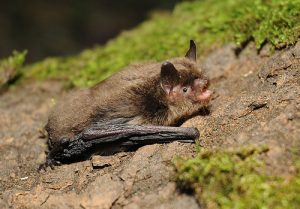
It’s one of the smallest bats in Extremadura. It has a long, frizzy coat and its colour can vary from reddish-brown to greyish-brown. Its distribution in Extremadura is very restricted, being present only in large reliefs north of Cáceres. The valleys of Ambroz, Jerte and Vera are home to its main populations, although it is also present in the most northwestern part of Gata.

